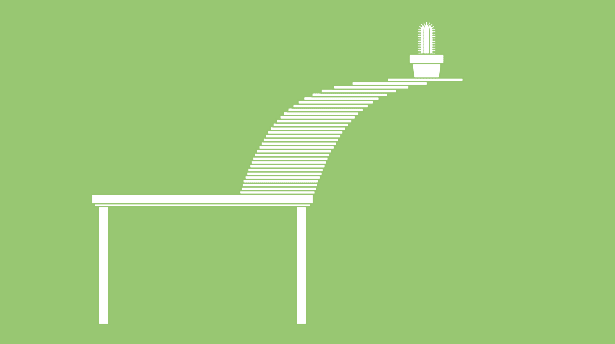How to Hang Far Out Over the Edge
In last month’s Insights puzzle and in my recent Abstractions blog posts, I dissected what we might call “over-projection” in election forecasts. This month, I turn to a different kind of over-projection — the fascinating phenomenon known as “overhang.”
You’ve surely played with overhang as a child. You stack a few identical flat objects such as playing cards, books or Jenga blocks overhanging the edge of a table so that the object at the bottom projects a little over the edge, the one resting on it projects a little more, the next one projects quite a bit more, and so on. The topmost object reaches out across space, a half-bridge to nowhere, defying gravity and seemingly supported by nothing. It looks cool and is fun to make. On a grander scale, cantilevered viewing platforms that overhang yawning chasms such as the Grand Canyon Skywalk and the Glacier Skywalk at Jasper National Park in Alberta, Canada, are truly spectacular and awe-inspiring.
Well, it turns out that the mathematics of overhang is equally entertaining, so let’s build our own overhanging towers using blocks and solve some puzzles about them.
Question 1
The classic overhang problem stipulates that all the blocks must be homogeneous, identical in shape and size and have a length of one unit; there can be only one block at every level of the stack; and none of the blocks can be bound or glued or attached to one another in any way. If you had five such blocks, what is the maximum horizontal distance that the tip of the top block can be made to project past the edge of the table? Can you derive a formula for the maximum overhang possible for n blocks?
Those who feel intimidated by the physics can relax. The stack of blocks can be modeled with a simple and elegant mathematical series. Here’s how you can think about it: If you start with just one block, it is obvious that the most you can get it to project is up to half its length — an overhang of one-half of a unit. Any more, and it will tip over. Now you can lift this block in place and put another block under it, resting on the table with its end flush with the table’s edge. Now slide both blocks forward as far as they will go without tipping over. The distance can be determined with a simple rule that I’ll state here without proof: The total length of the portions of all the blocks hanging out in space must equal the total length of the portions that are above the table and therefore supported by it. (Update: As reader Greg Egan pointed out, this shortcut rule is only accurate for the first three stack levels. This will be enough to give you a sense of the pattern of the mathematical series but not to apply it as stated for the fourth and fifth levels in Question 1. For a more general statement of the shortcut that applies to all levels, see Greg’s comment and my reply.) Now you can add another block below the two and push out all three blocks following the same rule. You can keep doing this indefinitely. That’s all you need to solve this problem.
Next let’s get into some simple variations that will require a deeper understanding of the physics. The key principle is to balance the torque of the supported and unsupported portions. The overhanging portion of the stack has a torque (its weight multiplied by the distance from its center of mass to the edge of the table) that cannot exceed the torque of the supported part of the stack, or the stack will tip over. By applying this physical principle you can derive the rule I stated above and tackle our second question.
Question 2
Imagine that you have the same five blocks as before, and you want to balance a little ornament on the topmost overhanging block, at the point on its center line located a quarter of the block’s length away from the overhanging end. The blocks all weigh one unit and the ornament weighs one-fifth of a unit. What’s the maximum overhang possible now? How does this change the general formula for maximum overhang?
Question 3
Imagine that you are competing against your friend in a multi-round game that involves creating overhanging structures. Initially, the two of you are each given a single block. You each have to place your block over an edge of your respective tables, with any amount of overhang you want. Then, you are each given one to four additional blocks, with the number chosen at random. (You both get the same number of additional blocks.) Each round starts with your initial block as the base, without changing its original position, and with a new random set of one to four blocks to add on top. How far over the edge should you place your initial block so that you have the largest possible average overhang over many rounds of this game?
The maximum-overhang formula yields a mathematical series that diverges. Astoundingly, this means that you can keep adding blocks and the amount of overhang will keep increasing forever, without limit! Obviously, this is not possible with real blocks: At some point the overhanging bridge will come crashing down. What are the physical constraints that will prevent a hypothetical mathematical bridge to infinity?
To close, I encourage you to create the largest overhanging stack of Jenga blocks that you can. Theoretically, it is possible to get an overhang of two unit lengths using 31 blocks. In practice you will probably need more. There are also more efficient solutions that we didn’t consider here, ones that do not follow the constraint of one block per level. Let us know what your personal best is, with and without the one block per level constraint. You can even include links to pictures of your gravity-defying constructions (you can upload pictures to internet image storage sites like Imgur and Flickr). We will include images of the most magnificent overhanging towers in our solution column.
Have fun stacking and puzzling. Just don’t go too far over the edge.
Editor’s note: The reader who submits the most interesting, creative or insightful solution (as judged by the columnist) in the comments section will receive a Quanta Magazine T-shirt. And if you’d like to suggest a favorite puzzle for a future Insights column, submit it as a comment below, clearly marked “NEW PUZZLE SUGGESTION” (it will not appear online, so solutions to the puzzle above should be submitted separately).
Note that we may hold comments for the first day or two to allow for independent contributions by readers.
Update: The solution has been published here.




